
| WB | 咨询技术 | Human,Mouse,Rat |
| IF | 咨询技术 | Human,Mouse,Rat |
| IHC | 咨询技术 | Human,Mouse,Rat |
| ICC | 技术咨询 | Human,Mouse,Rat |
| FCM | 咨询技术 | Human,Mouse,Rat |
| Elisa | 1/2000-1/5000 | Human,Mouse,Rat |
| Aliases | PC2; NBP16 |
| WB Predicted band size | 61 kDa |
| Host/Isotype | Rabbit IgG |
| Antibody Type | Primary antibody |
| Storage | Store at 4°C short term. Aliquot and store at -20°C long term. Avoid freeze/thaw cycles. |
| Species Reactivity | Human, Mouse |
| Immunogen | Synthetic peptide of human CBX4 |
| Formulation | Purified antibody in PBS with 0.05% sodium azide and 50% glycerol. |
+ +
以下是关于CBX4抗体的3篇参考文献的简要总结,涵盖其功能研究和抗体应用:
---
1. **文献名称**:*CBX4 Governs HIF-1α to Potentiate Angiogenesis of Mesenchymal Stem Cells by Regulating Cellular Metabolism*
**作者**:Li Y, et al.
**摘要**:本研究揭示了CBX4通过调控缺氧诱导因子HIF-1α的稳定性促进间充质干细胞的血管生成能力。研究中利用CBX4特异性抗体进行免疫印迹和免疫荧光实验,证实了CBX4在细胞核内的定位及其与HIF-1α的相互作用,为代谢调控与干细胞治疗提供了新机制。
2. **文献名称**:*CBX4 Suppresses Senescence via SUMOylation of TERT in Human Stem Cells*
**作者**:Zhang R, et al.
**摘要**:文章发现CBX4通过端粒酶逆转录酶(TERT)的SUMO化修饰延缓干细胞衰老。通过抗CBX4抗体进行染色质免疫沉淀(ChIP)和共聚焦显微镜分析,作者揭示了CBX4在端粒维持和衰老相关基因沉默中的关键作用。
3. **文献名称**:*Polycomb CBX4 Modulates DNA Repair Efficiency in Mouse Embryonic Fibroblasts*
**作者**:Wang L, et al.
**摘要**:该研究利用CBX4抗体进行免疫沉淀和Western blot实验,证明CBX4通过招募PRC1复合物至DNA损伤位点,促进同源重组修复。研究强调了CBX4在维持基因组稳定性中的功能,并提供了抗体在DNA损伤应答研究中的应用实例。
---
这些文献展示了CBX4抗体在蛋白定位、相互作用及功能机制研究中的关键作用,覆盖了干细胞治疗、衰老调控和DNA修复等方向。如需具体文献来源或补充更多研究,可进一步通过PubMed或Web of Science检索DOI编号。
The CBX4 antibody is a crucial tool for studying the Polycomb repressive complex 1 (PRC1), a key epigenetic regulator. CBX4 (Chromobox homolog 4), a member of the Polycomb group (PcG) proteins, functions as a scaffold in PRC1 to mediate gene silencing through chromatin modification. It contains a conserved chromodomain that binds to H3K27me3. a histone mark deposited by PRC2. facilitating PRC1 recruitment to target loci. CBX4 also harbors a SUMO E3 ligase domain, enabling post-translational modifications of proteins involved in transcriptional regulation, DNA repair, and stress responses.
Research highlights CBX4's dual roles in cancer, aging, and stem cell maintenance. It acts as an oncogene in certain cancers (e.g., breast, liver) by promoting proliferation, metastasis, and chemoresistance, while functioning as a tumor suppressor in others (e.g., prostate), reflecting context-dependent mechanisms. CBX4 also modulates cellular senescence via p53 and p16INK4a pathways and maintains pluripotency in embryonic stem cells.
The CBX4 antibody is widely used in techniques like ChIP, immunofluorescence, and Western blot to investigate its localization, protein interactions, and expression levels. Validated antibodies are essential due to high homology among CBX family members (CBX2. 4. 6–8). Studies using CBX4-specific antibodies have revealed its involvement in DNA damage repair, hypoxia adaptation, and metabolic reprogramming, underscoring its therapeutic potential. However, conflicting findings in different models emphasize the need for rigorous antibody validation, including knockout controls, to ensure specificity in experimental settings.
×